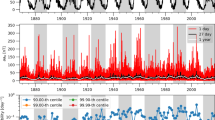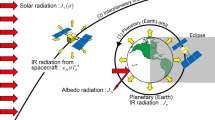Abstract
This paper summarizes some of the main conclusions and highlights of the Emerging Concepts Working Group (EC Group) of the Snowmass 1999 Fusion Summer Study. The EC Group considered technical challenges and opportunities related to emerging concept issues.
Similar content being viewed by others
REFERENCES
George Cayley produced a sketch and model glider in 1804, which is the first known example of a fixed-wing, fuselage, dual-plane tail airplane. The Wright Brothers, of course, flew in 1903. A fascinating account of the development of flight from the viewpoint of aerodynamics is contained in: John D. Anderson, Jr, A History of Aerodynamics. (Cambridge University Press, Cambridge UK) (1997).
An excellent and fairly modern exposition of the history of cancer research can be found in M. B. Shimkin, Contrary to Nature, (DHEW pub. No. (NIH) 79-720; United States Printing Office, Washington, DC) (1977).
H. A. B. Bodin and A. A. Newton (1980). Nucl. Fusion 20, 1255; M. R. Stoneking, N. E. Lanier, S. C. Prager, J. S. Sarff, and D. Sinitsyn (1997). Phys. of Plasmas 4, 1632.
E. B. Hooper, L. D. Pearlstein, and R. H. Bulmer (1999). Nucl. Fusion 39, 863; T. R. Jarboe (1994). Plasma Phys. Control Fusion 36, 945.
M. Tuszewski (1988). Nucl. Fusion 28, 2033.
Yu. A. Omelchenko and R. N. Sudan (1995). Phys. Plasmas 2, 2773.
K. F. Schoenberg and R. E. Siemon, Eds., “Magnetized Target Fusion—A Proof-of-Principle Research Proposal,” Los Alamos National Laboratory Report LA-UR-98-2413 (May 19, 1998); See also http://fusionenergy.lanl.gov/mtf.htm#MTF
A. Hasegawa (1987), Comm Pl Phys & Cont Fus, 1, 147; J. Kesner, L. Bromberg, D. Garnier, M. Mauel (1998), 17th IAEA Fusion Energy Conf., Paper IAEA-F1-CN-69-ICP/09 Yokohama, Japan.
A. B. Hassam (1997). Comments on Plasma and Controlled Fusion 18, 263; additional information available at http://www.glue.umd.edu/~hassam/snomass/snomass_index.htm
R. F. Post, D. D. Ryutov (1995). Comments on Plasma Physics and Controlled Fusion 16, 375; D. E. Baldwin, E. B. Hooper, D. D. Ryutov, K. I. Thomassen. “A high-flux source of fusion neutrons for material and component testing,” Lawrence Livermore National Laboratory report UCRL-JC-132853, January 1999.
R. A. Nebel and D. C. Barnes (1998). Fusion Technology 34, 28.
C. W. Hartman, G. Carlson, M. Hoffman, R. Werner, and D. Y. Cheng (1977). Nucl. Fusion 17, 909; U. Shumlak and C.W. Hartman (1995). Phys. Rev. Lett. 75, 3285.
M. Tabak, J. H. Hammer, M. E. Glinsky, W. L. Kruer, S. C. Wilks, J. Woodworth, E. M. Campbell, and M. D. Perry (1994). Phys. Plasmas 1, 5.
Information is available at http://www.fusionstar.de/.
Author information
Authors and Affiliations
Rights and permissions
About this article
Cite this article
Barnes, D.C., Hammer, J., Hassam, A. et al. Fusion Energy Science Opportunities in Emerging Concepts. Journal of Fusion Energy 18, 13–17 (1999). https://doi.org/10.1023/A:1018814706158
Issue Date:
DOI: https://doi.org/10.1023/A:1018814706158




